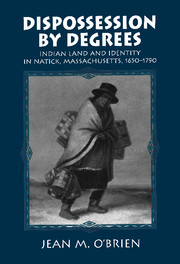Book contents
- Frontmatter
- Contents
- List of illustrations
- Acknowledgments
- Prologue: “My land”: Natick and the narrative of Indian extinction
- 1 Peoples, land, and social order
- 2 The sinews and the flesh: Natick comes together, 1650–75
- 3 “Friend Indians”: Negotiating colonial rules, 1676–1700
- 4 Divided in their desires, 1700–40
- 5 Interlude: the proprietary families
- 6 “They are so frequently shifting their place of residence”: Natick Indians, 1741–90
- Conclusion
- Index
Prologue: “My land”: Natick and the narrative of Indian extinction
Published online by Cambridge University Press: 04 August 2010
- Frontmatter
- Contents
- List of illustrations
- Acknowledgments
- Prologue: “My land”: Natick and the narrative of Indian extinction
- 1 Peoples, land, and social order
- 2 The sinews and the flesh: Natick comes together, 1650–75
- 3 “Friend Indians”: Negotiating colonial rules, 1676–1700
- 4 Divided in their desires, 1700–40
- 5 Interlude: the proprietary families
- 6 “They are so frequently shifting their place of residence”: Natick Indians, 1741–90
- Conclusion
- Index
Summary
The button-wood trees, in front of the south tavern, were set out in 1783 … Their being planted on the Indian burying ground gave offence to some of the few remaining individuals of the tribe; and one poor girl, with a mixture of grief and anger, endeavoured to uproot them; but they resisted her efforts, as they have many a violent storm, are still in a thriving condition, and measure 17 feet in circumference, at the height of two feet from the ground.
The narrative construction
This passage by William Biglow, from the section on “Remarkable Trees” in the first published history of Natick, Massachusetts (1830), describes a scene rich with symbolism. In planting buttonwood trees in front of a tavern and on the Indian burying ground, the relatively recently arrived English residents of the once all-Indian community engaged in a colonial act. In “grief and anger,” an offended Indian girl defiantly resisted this deed of desecration and erasure, presumably hoping to defend the graves and memory of her people. By the 1780s, the Indian burying ground constituted one of the last places within the town that Indians could claim as their own.
These were not the only Natick trees Biglow found remarkable. The others he wrote about served to mark the Indian-mission origin of the town. He noted two oaks that grew upon the place English Calvinist missionary John Eliot preached to the Indians (between 1650 and 1690).
- Type
- Chapter
- Information
- Dispossession by DegreesIndian Land and Identity in Natick, Massachusetts, 1650–1790, pp. 1 - 12Publisher: Cambridge University PressPrint publication year: 1997

